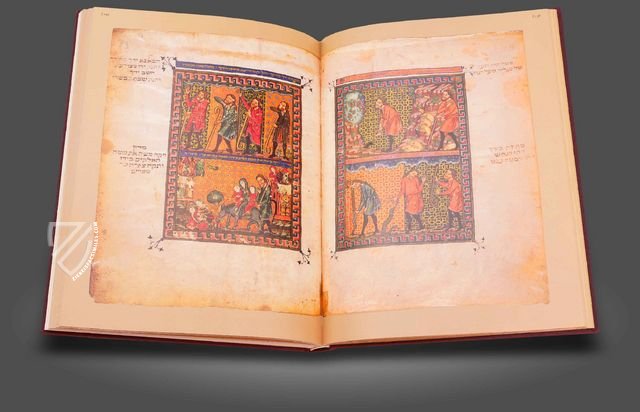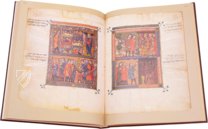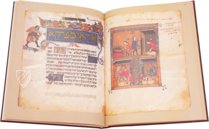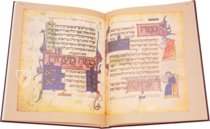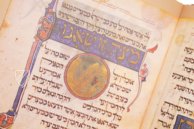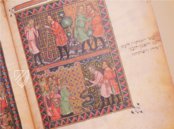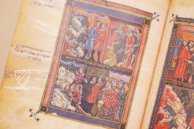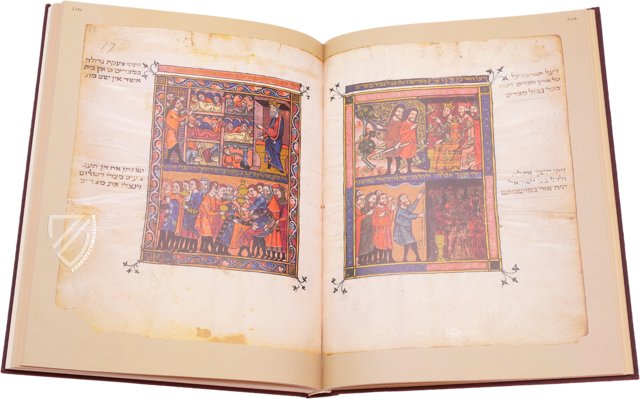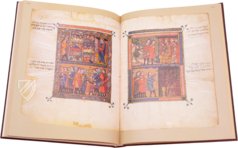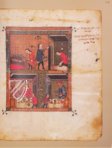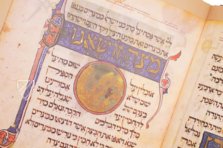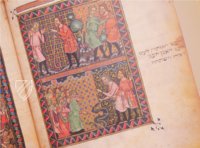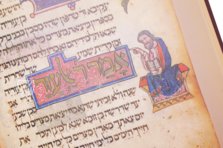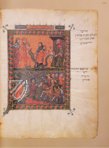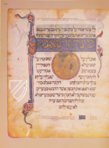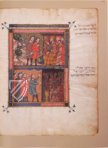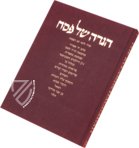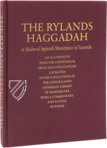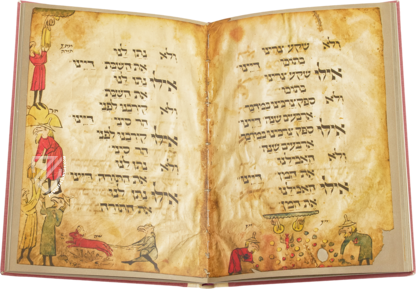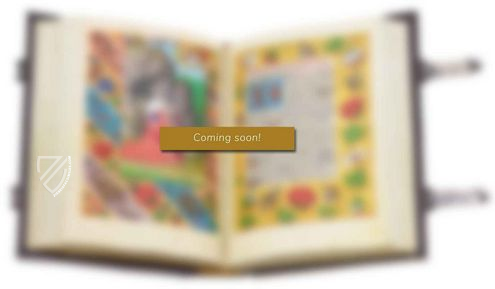Rylands Haggadah
(under 1,000€)
The Rylands Haggadah is not only one of the most richly adorned Haggadot to survive today but is also a precious source for the study of medieval Jewish art in general. Aside from the eleven highly artful full-page miniatures illustrating the events of the Book of Exodus, the manuscript also features decorative initial-word panels, floral motifs, and is distinguished by its very fine drolleries depicting various grotesques and hybrids. Created in Catalonia, Spain ca. 1330, it contains the Sephardic rite for the Passover Seder and includes a depiction of a Passover celebration. Finally, the manuscript is also a marvelous example of the religious, cultural, and artistic exchange that occurred between the Jews and their Christian neighbors during the High Middle Ages.
Rylands Haggadah
Containing the Sephardic rite for the Passover Seder, this splendidly illuminated Haggadah is one of the finest examples of medieval Jewish art to survive today and is also a testament to the artistic cross-pollination that occurred between Jewish illuminators and their non-Jewish counterparts. The Rylands Haggadah originated in Spanish Catalonia ca. 1330 and is adorned by a 13-page miniature cycle depicting the Book of Exodus from Moses and the Burning Bush to the Crossing of the Red Sea and the roasting of the first Passover lamb as well as numerous decorative initial-word panels and drolleries. These centaurs, archers, animals, and grotesques are also some of the finest examples of the playful, often satirical drolleries that were popular in medieval art.
A Masterpiece of Jewish Art
The Rylands Haggadah has 57 vellum leaves that are richly adorned with gold and a palette of primary colors, primarily red and blue, making it one of the most splendid Haggadot in existence, which also made it a highly coveted work of art. Aside from being one of the finest Haggadot in the world, it is also a precious source for the study of medieval Jewish art in general. The manuscript was modelled on the so-called Barcelona Haggadah from the British Library but its gorgeous imagery is even more graphic with gory descriptions of the suffering of the Egyptians as they are afflicted by one plague after another. It was acquired in 1901 by Enriqueta Rylands (1843–1908), a British philanthropist and founder of the John Rylands Library in Manchester, where the masterpiece is housed today.
Artistic Cross-Pollination
One of the most fascinating aspects of the manuscript is the evidence of influences from Christian art, much of which originated from stories in the Old Testament, which is to say Jewish themes. For example, in the Book of Matthew, Joseph flees to Egypt with Mary and the Baby Jesus after being warned by an angel that King Herod will seek to kill their son and is referred to in art to as the Flight into Egypt. This is generally seen as a parallel to the story of how Moses returned to Egypt with Tziporah and their two sons in Exodus 4:20-26. The image of Mary holding her child while riding on a donkey led by Joseph with a staff was already ubiquitous in the early 14th century and has been adapted in the Rylands Haggadah. Here the Return to Egypt depicts Tziporah on the donkey holding one child in front while her second child clings to her back as Moses guides them along. The miniature is thus an appropriation of a Christian image that was itself based on the adoption of a Jewish text. This finely crafted image perfectly epitomizes artistic/cultural exchange and “cross-pollination” that occurred between Jews and Christians during the Middle Ages.
Codicology
- Origin
- Spain
- Date
- Ca. 1330
- Epochs
- Language
- Script
- Hebrew Square Script
- Illustrations
- 13 full-page miniatures, 12 marginal vignettes, dozens of ornamented headpieces and pen-flourish initials
- Content
- Texts with instructions for the Passover Seder as well as annotated poems for the Passover week and the Sabbath before Passover
- Previous Owners
- James Ludovic Lindsay
Earl of Crawford
Enriqueta Rylands
Rylands Haggadah
Influences from Christian art
On the one hand, the Haggadah serves as a valuable source for the study of medieval Jewish art, but it also shows Christian influences. This miniature exemplifies the religious, cultural and artistic exchange between Jewish and Christian artistic creation in the period of the High Middle Ages. The scene shows Moses returning to Egypt with Tzipora and her two sons. While Moses leads the animal, Tzipora sits on the donkey with the two children. The scene is based on the flight from Egypt from the Old Testament, when Mary rides on the donkey with the baby Jesus, who is led by Joseph with a staff. This miniature can thus be seen as an appropriation of Old Testament iconography and shows the mutual inspiration of religions during the Middle Ages.

Rylands Haggadah
The first Passover lamb
The impressive Haggadah is particularly captivating because of its rich decoration. In addition to the ornate initials, floral motifs and fine drolleries of grotesques, the Ryland Haggadah contains a picture cycle illustrating the Book of Exodus in elaborate miniatures. The miniatures, set in magnificent gold and coloured frames, are each divided into different zones showing different events of the Book of Exodus.
This miniature shows the so-called Pesach or Passcha or Passa festival, which is one of the high festivals of the Jewish calendar. The festival, which lasts several days, commemorates the exodus from Egypt and thus the liberation of the people of Israel from slavery (Exodus 12). On the evening before the Passover, as on the first Passover night, a lamb is slaughtered.
In the upper section of the picture this essential part of the Passover meal, the slaughter of the lamb as well as the preparation over the fire can be seen. The blood is used to coat the doorposts and the lintel of the houses. The lower section of the picture then shows the meal itself, which is to take place in the circle of the family. The miniature is captivating here because of the detailed depiction, such as the four wine glasses that are drunk symbolically for the liberation from enslavement in Egypt.
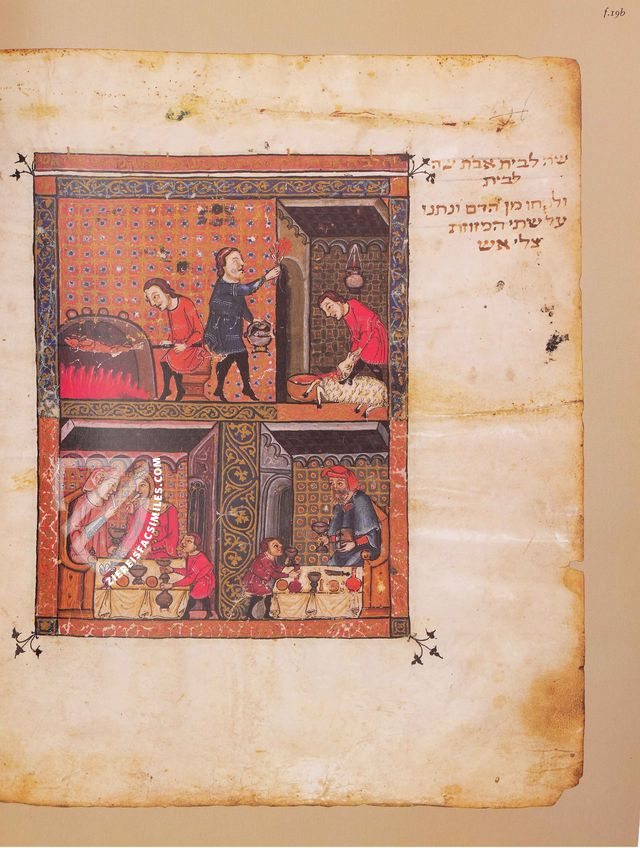
#1 The Rylands Haggadah
Languages: English, Hebrew
(under 1,000€)
- Treatises / Secular Books
- Apocalypses / Beatus
- Astronomy / Astrology
- Bestiaries
- Bibles / Gospels
- Chronicles / History / Law
- Geography / Maps
- Saints' Lives
- Islam / Oriental
- Judaism / Hebrew
- Single Leaf Collections
- Leonardo da Vinci
- Literature / Poetry
- Liturgical Manuscripts
- Medicine / Botany / Alchemy
- Music
- Mythology / Prophecies
- Psalters
- Other Religious Books
- Games / Hunting
- Private Devotion Books
- Other Genres
- Afghanistan
- Armenia
- Austria
- Belgium
- Colombia
- Croatia
- Cyprus
- Czech Republic
- Denmark
- Egypt
- Ethiopia
- France
- Germany
- Greece
- Hungary
- India
- Iran
- Iraq
- Israel
- Italy
- Japan
- Lebanon
- Luxembourg
- Mexico
- Morocco
- Netherlands
- Palestine
- Peru
- Poland
- Portugal
- Russia
- Serbia
- Spain
- Sri Lanka
- Sweden
- Switzerland
- Syria
- Turkey
- Ukraine
- United Kingdom
- United States
- Uzbekistan
- Aboca Museum
- Ajuntament de Valencia
- Akademie Verlag
- Akademische Druck- u. Verlagsanstalt (ADEVA)
- Aldo Ausilio Editore - Bottega d’Erasmo
- Alecto Historical Editions
- Alkuin Verlag
- Almqvist & Wiksell
- Amilcare Pizzi
- Andreas & Andreas Verlagsbuchhandlung
- Archa 90
- Archiv Verlag
- Archivi Edizioni
- Arnold Verlag
- ARS
- Ars Magna
- ArtCodex
- AyN Ediciones
- Azimuth Editions
- Badenia Verlag
- Bärenreiter-Verlag
- Belser Verlag
- Belser Verlag / WK Wertkontor
- Benziger Verlag
- Bernardinum Wydawnictwo
- BiblioGemma
- Biblioteca Apostolica Vaticana (Vaticanstadt, Vaticanstadt)
- Bibliotheca Palatina Faksimile Verlag
- Bibliotheca Rara
- Boydell & Brewer
- Bramante Edizioni
- Bredius Genootschap
- Brepols Publishers
- British Library
- C. Weckesser
- Caixa Catalunya
- Canesi
- CAPSA, Ars Scriptoria
- Caratzas Brothers, Publishers
- Carus Verlag
- Casamassima Libri
- Chavane Verlag
- Christian Brandstätter Verlag
- Circulo Cientifico
- Club Bibliófilo Versol
- Club du Livre
- CM Editores
- Collegium Graphicum
- Collezione Apocrifa Da Vinci
- Comissão Nacional para as Comemorações dos Descobrimentos Portugueses
- Coron Verlag
- Corvina
- CTHS
- D. S. Brewer
- Damon
- De Agostini/UTET
- De Nederlandsche Boekhandel
- De Schutter
- Deuschle & Stemmle
- Deutscher Verlag für Kunstwissenschaft
- DIAMM
- Droz
- E. Schreiber Graphische Kunstanstalten
- Ediciones Boreal
- Ediciones Grial
- Ediclube
- Edições Inapa
- Edilan
- Editalia
- Edition Deuschle
- Edition Georg Popp
- Edition Leipzig
- Edition Libri Illustri
- Editiones Reales Sitios S. L.
- Éditions de l'Oiseau Lyre
- Editions Medicina Rara
- Editorial Casariego
- Editorial Mintzoa
- Editrice Antenore
- Editrice Velar
- Edizioni Edison
- Egeria, S.L.
- Eikon Editores
- Electa
- Emery Walker Limited
- Enciclopèdia Catalana
- Eos-Verlag
- Ephesus Publishing
- Ernst Battenberg
- Eugrammia Press
- Extraordinary Editions
- Fackelverlag
- Facsimila Art & Edition
- Facsimile Editions Ltd.
- Facsimilia Art & Edition Ebert KG
- Faksimile Verlag
- Feuermann Verlag
- Folger Shakespeare Library
- Franco Cosimo Panini Editore
- Friedrich Wittig Verlag
- Fundación Hullera Vasco-Leonesa
- G. Braziller
- Gabriele Mazzotta Editore
- Gebr. Mann Verlag
- Gesellschaft für graphische Industrie
- Getty Research Institute
- Giovanni Domenico de Rossi
- Giunti Editore
- Graffiti
- Grafica European Center of Fine Arts
- Guido Pressler
- Guillermo Blazquez
- Gustav Kiepenheuer
- H. N. Abrams
- Harrassowitz
- Helikon
- Hendrickson Publishers
- Henning Oppermann
- Herder Verlag
- Hes & De Graaf Publishers
- Hoepli
- Holbein-Verlag
- Hortus Deliciarum
- Houghton Library
- Hugo Schmidt Verlag
- Idion Verlag
- Il Bulino, edizioni d'arte
- ILte
- Imago
- Insel Verlag
- Instituto Nacional de Antropología e Historia
- Istituto dell'Enciclopedia Italiana - Treccani
- Istituto Ellenico di Studi Bizantini e Postbizantini
- Istituto Geografico De Agostini
- Istituto Poligrafico e Zecca dello Stato
- Italarte Art Establishments
- J. Thorbecke
- Jan Thorbecke Verlag
- Johnson Reprint Corporation
- Josef Stocker
- Josef Stocker-Schmid
- Jugoslavija
- Karl W. Hiersemann
- Kasper Straube
- Kaydeda Ediciones
- Kindler Verlag / Coron Verlag
- Kodansha International Ltd.
- Konrad Kölbl Verlag
- Kurt Wolff Verlag
- La Liberia dello Stato
- La Linea Editrice
- La Meta Editore
- Lambert Schneider
- Landeskreditbank Baden-Württemberg
- Leo S. Olschki
- Les Incunables
- Library of Congress
- Libreria Musicale Italiana
- Lichtdruck
- Lito Immagine Editore
- Lumen Artis
- Lund Humphries
- M. Moleiro Editor
- Maison des Sciences de l'homme et de la société de Poitiers
- Manuscriptum
- Martinus Nijhoff
- Maruzen-Yushodo Co. Ltd.
- MASA
- McGraw-Hill
- Militos
- Millennium Liber
- Müller & Schindler
- Nahar and Steimatzky
- National Library of Wales
- Neri Pozza
- Nova Charta
- Oceanum Verlag
- Odeon
- Orbis Mediaevalis
- Orbis Pictus
- Österreichische Staatsdruckerei
- Oxford University Press
- Pageant Books
- Parzellers Buchverlag
- Patrimonio Ediciones
- Pattloch Verlag
- PIAF
- Pieper Verlag
- Plon-Nourrit et cie
- Prestel Verlag
- Princeton University Press
- Prisma Verlag
- Priuli & Verlucca, editori
- Pro Sport Verlag
- Propyläen Verlag
- Pytheas Books
- Quaternio Verlag Luzern
- Reales Sitios
- Recht-Verlag
- Reichert Verlag
- Reichsdruckerei
- Riehn & Reusch
- Roberto Vattori Editore
- Rosenkilde and Bagger
- Roxburghe Club
- Salerno Editrice
- Sarajevo Svjetlost
- Schöck ArtPrint Kft.
- Scolar Press
- Scrinium
- Scripta Maneant
- Scriptorium
- Siloé, arte y bibliofilia
- SISMEL - Edizioni del Galluzzo
- Sociedad Mexicana de Antropología
- Société des Bibliophiles & Iconophiles de Belgique
- Soncin Publishing
- Sorli Ediciones
- Stainer and Bell
- Studer
- Styria Verlag
- Sumptibus Pragopress
- Szegedi Tudomànyegyetem
- Taberna Libraria
- Tarshish Books
- Taschen
- Tempus Libri
- Testimonio Compañía Editorial
- Thames and Hudson
- The Clear Vue Publishing Partnership Limited
- The Facsimile Codex
- The Folio Society
- The Marquess of Normanby
- The Richard III and Yorkist History Trust
- Tip.Le.Co
- TouchArt
- TREC Publishing House
- TRI Publishing Co.
- Trident Editore
- Typis Regiae Officinae Polygraphicae
- Union Verlag Berlin
- Universidad de Granada
- University of California Press
- University of Chicago Press
- Urs Graf
- Vallecchi
- Van Wijnen
- VCH, Acta Humaniora
- VDI Verlag
- VEB Deutscher Verlag für Musik
- Verlag Anton Pustet / Andreas Verlag
- Verlag Bibliophile Drucke Josef Stocker
- Verlag der Münchner Drucke
- Verlag für Regionalgeschichte
- Verlag Styria
- Vicent Garcia Editores
- W. Turnowsky
- Waanders Printers
- Wiener Mechitharisten-Congregation (Wien, Österreich)
- Wissenschaftliche Buchgesellschaft
- Wydawnictwo Dolnoslaskie
- Xuntanza Editorial
- Zakład Narodowy
- Zollikofer AG

